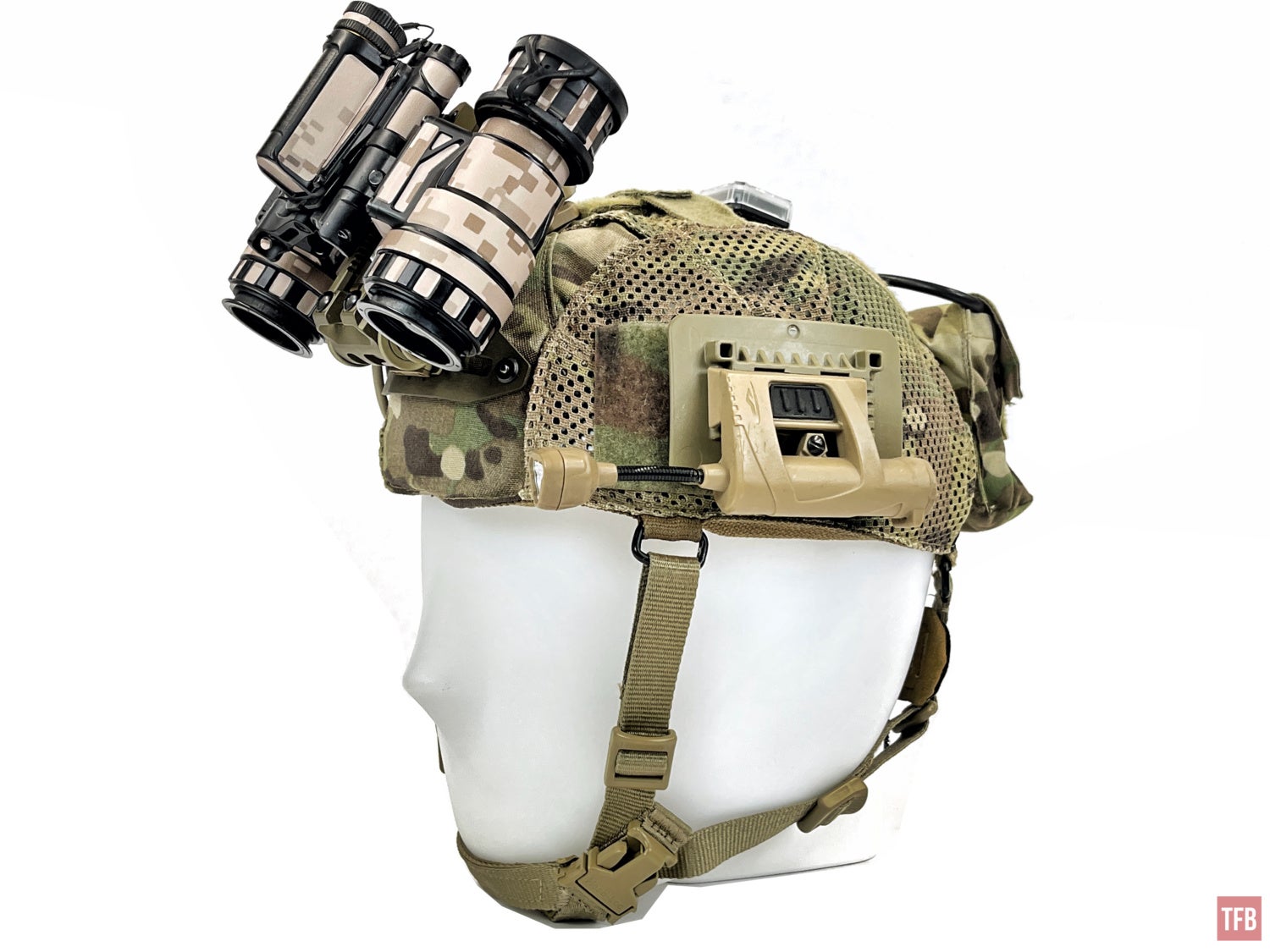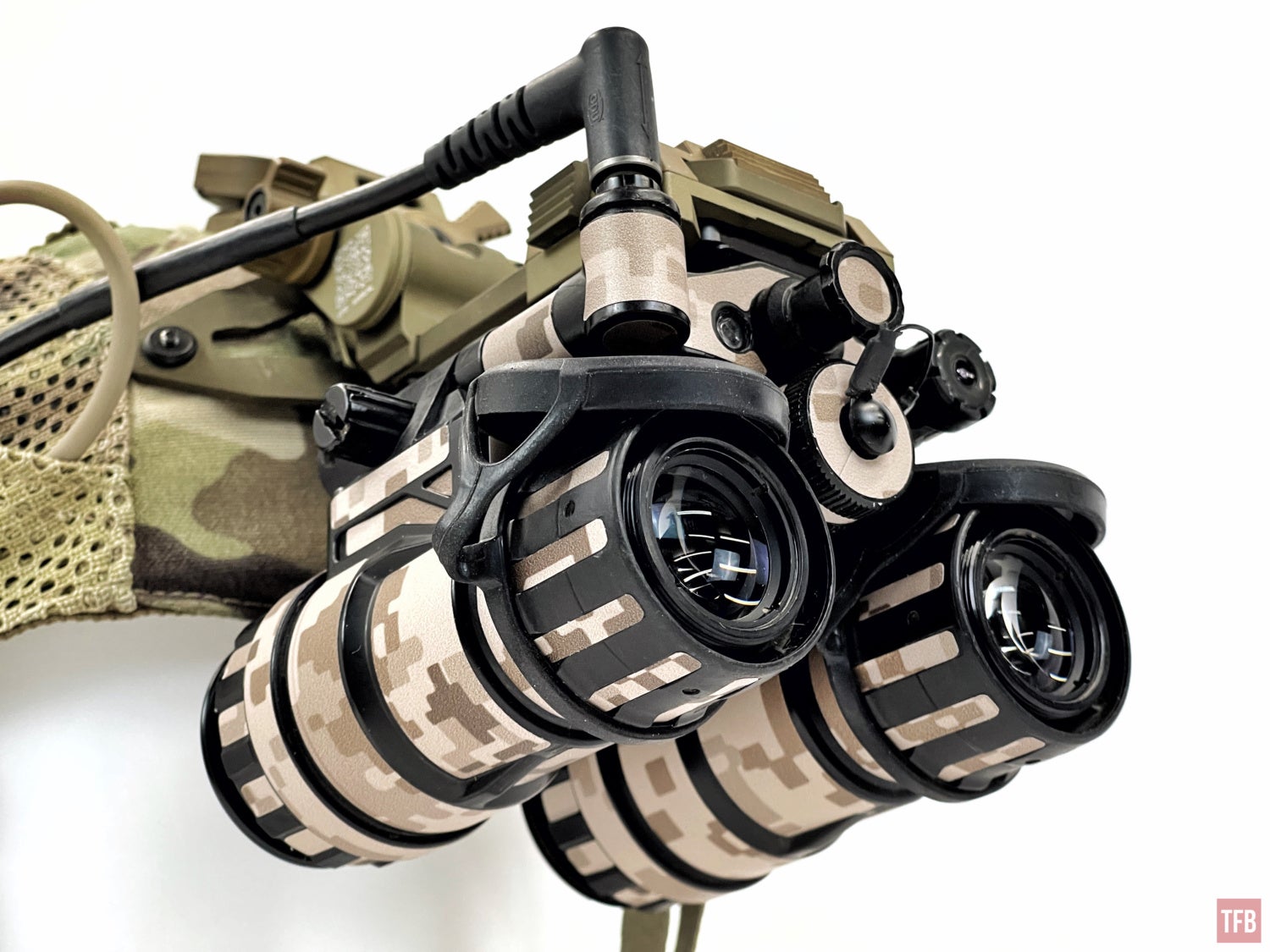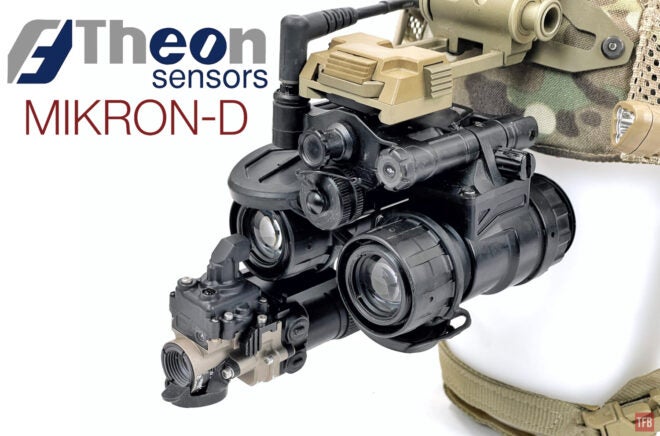Hello nocturnal enthusiasts and welcome back to another Friday Night Lights. Last week we took a look at some alternative ANVIS systems. Well, this week we look at something you might consider unique, for the US market. The Theon Sensors MIKRON-D is their lightweight binocular night vision goggle. Let’s take a close look at this Greek goggle.
More Dual Tube NVGs @ TFB:
- Friday Night Lights: Dual Tube Spotlight – Elbit F5032 SBNVG/PVS-31D
- Friday Night Lights: Dual Tube Spotlight – EOTech BinoNV-C
- Friday Night Lights: Nocturn Industries UANVB-OC and Micro
MIKRON-D? Don’t You Mean BinoNV-C?
Yes and at the same time … no. It is the other way around. The BinoNV-C by EOTech is actually a Theon Sensors MIKRON-D but with white phosphor tubes. We looked at the BinoNV-C almost a year ago. And we looked at the bigger version, the Elbit F5032, almost 2 years ago. Well, the MIKRON-D is slightly different from the BinoNV-C. First off this one has green phosphor 16mm Photonis image intensifiers which makes it rather unique for the US market. Here it is next to my friend Greg’s F5032 (the same one I reviewed).



The MIKRON-D uses 16mm Photonis image intensifiers to reduce the size and weight. You can see how much smaller the MIKRON-D is compared to the Elbit F5032 which uses standard 18mm 11769 image intensifiers. But do you notice anything else different? Look at the dovetails. The BinoNV-C has the same dovetail as the F5032 but the MIKRON-D does not.

Why would Theon Sensors design the MIKRON-D dovetail like that? It is for their mount. The dovetail has contacts that create a closed circuit with the mount. The mount has a reed relay to shut power to the goggle when it is flipped up. Just like the BinoNV-C, the MIKRON-D also has reed relays in the pods so when they fold away, power is shut to each tube.
According to a contact at Theon Sensors, the Theon Sensor housings with contactless dovetails have an embedded accelerometer so they shut off when they are flipped up on a helmet but this is not as reliable. If you have your goggles folded up on your helmet and you bend down to pick something up, the accelerometer will turn the goggle back on.

Do you see those notches on the sides of the MIKRON-D dovetail? The Theon Sensors mount uses that to lock the dovetail in. You can see the corresponding silver-colored pin that is held in place with a spring. Like other NVG mounts, the Theon Sensors mount flips up.


This mount has a different way to achieve the same adjustments found in other NVG mounts. The knurled knob at the top of the mount is for adjusting the mount up and down. Similar to a Norotos AKA2, it has fine threads so while it is nice for dialing in the position, it is not fast and takes many turns to move the mount.

The tilt adjustment is controlled by this smaller knurled knob.

There is a lot of tilt adjustment in this mount.


At the end of the mount is the dovetail shoe. The large disc is for releasing the shoe and allowing you to slide it forward or backward to set the eye relief of the goggle to your eyes. The small smooth button on the side is what releases the locking pin so you can remove the MIKRON-D dovetail from the mount.

The dovetail shoe slides on a cylindrical rod but it does not rotate around it like the INVG mount from Norotos or the PSQ-20B mount.


Due to the design, the mount is not that low-profile. Even with the MIKRON-D pods folded away, they are a considerable distance from the helmet.

Compare that to the photo below.


MIKRON-D wrapped in AOR1 by Nocorium
The dovetail on the MIKRON-D is not proprietary but due to its position, it makes using other mounts difficult. My Wilcox G24 is too wide and before it can lock the dovetail in place, it hits the remote power port. This is probably why the contactless dovetail is further back on the bridge than this MIKRON-D. It can lock into the wider Wilcox G24 dovetail shoe without touching the remote power port.

However, I was able to get it to mount to my Wilcox G69. And there is room for the remote battery pack cable.

SBNVG Revisted
This leads us to revisiting the SBNVG, which is what the US Marines are using only I am using a MIKRON-D and ECOSI rather than the F5032 and an ECOTI.

Thanks to Scott at Nocturnality Gear for selling me this SBNVG battery pack and y-split cable. So now I can power the MIKRON-D and ECOSI with a remote battery pack. The mount I used to attach the ECOSI to my modified SiOnyx Aurora Pro is actually for the SBNVG F5032. It can mount to the MIKRON-D in the same way but the diameter of the housing is a little bit narrower than the F5032. So I made a shim using spare Nocorium vinyl wrap and now the mount fits perfectly.

Here is the ECOTI mount on my friend’s F5032.


Aside from the fact this is an ECOSI, this is the SBNVG setup.

According to my Theon Sensors contact, there are actually three different battery packs for the NYX aka SBNVG/F5032. There is a full metal 2-cell battery pack, a full plastic 4-cell (which is what Harris was selling at the beginning of the F5032) and the current full plastic 3-cell battery pack you see below which is what comes issued with the SBNVG. He mentioned that the German KSK (Kommando Spezialkräfte) uses the full metal battery pack as a counterweight.


The Theon Sensors 3-cell battery pack weighs just 5.7 ounces. It has an odd shape due to the protrusion sticking out the side for plugging in the power cable. I am not sure why it is so bulky other than to ensure robustness. I think they could have minimized the battery pack more by removing that protrusion, having the port on the side of the battery pack and going with a 90º plug on both ends of the battery cable.


The battery pack uses three AA batteries. Some devices require lithium but so far the MIKRON-D seems to run just fine on alkaline AA batteries.

One issue I found with running the remote power cable is the length is limiting. On my Crye Nightcap, it is fine. I can adjust the position of the ECOSI how I want.


See the image above? The cable is too short if I have this setup on a helmet. I have to move the battery pack further up the helmet or don’t use the cable management loops in my helmet cover. I know, first-world problems.



Final Thoughts On The MIKRON-D


This MIKRON-D has green phosphor Photonis tubes. I have found Photonis’ green phosphor looks better to me than their white phosphor. This MIKRON-D did not come with spec sheets so I do not know the performance of these tubes but they look pretty good.



There is one aspect that does give me cause for concern and that is the eyecup retaining rings. I don’t use eyecups simply because I want to use my peripheral vision when I use night vision. I like to be able to see under and around my goggles. I removed the eyecup retaining rings and they are simply that, a flat ring with the tiniest of threads I have seen. They screw onto the outside of the eyepiece and I imagine those threads could get damaged pretty easily or this ring could get cross threaded.

There is a small difference on this MIKRON-D over the BinoNV-C and F5032 bridges. This unit has these molded protrusions that act as travel limiters for the articulating pods. The arm hits these bump stops to prevent overtravel. Not sure why the Elbit and EOTech versions do not have these. Maybe it is something Theon Sensors phased out in their current design?


I like the green phosphor a lot. And the weight is pretty nice. Without a AA battery, it is 14.2 ounces and that is with the Nocorium vinyl wrap.

With the battery pack and my modified Crye Nightcap, the entire setup is 2.5 lbs. Not bad for a lightweight setup for light use. Sadly 16mm tubes are very hard to come by and I heard a rumor that sales of 16mm night vision have been halted. Hopefully, Photonis will be willing to export some to the US and we can get lightweight binos that weigh as much or less than a standard PVS-14.
 Your Privacy Choices
Your Privacy Choices
